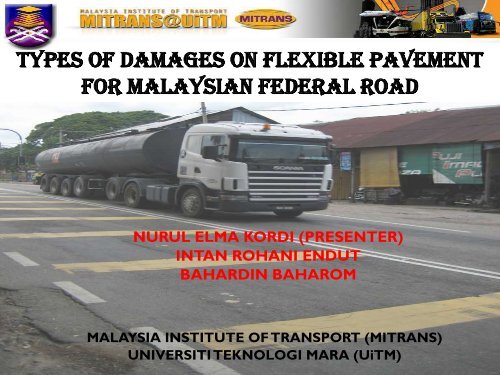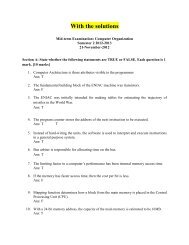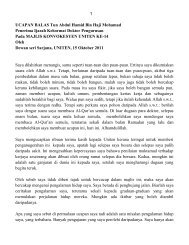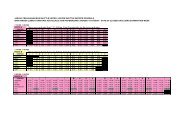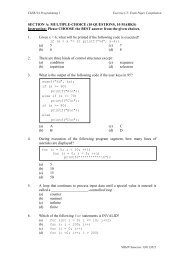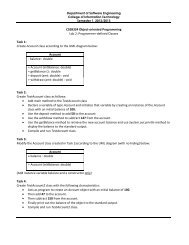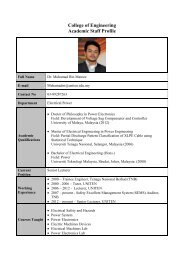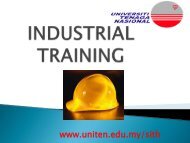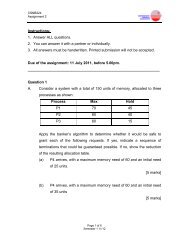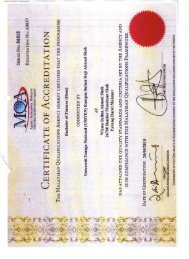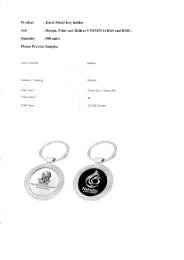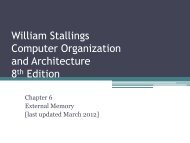types of damages on flexible pavement for malaysian federal road
types of damages on flexible pavement for malaysian federal road
types of damages on flexible pavement for malaysian federal road
You also want an ePaper? Increase the reach of your titles
YUMPU automatically turns print PDFs into web optimized ePapers that Google loves.
TYPES OF DAMAGES ON FLEXIBLE PAVEMENT<br />
FOR MALAYSIAN FEDERAL ROAD<br />
NURUL ELMA KORDI (PRESENTER)<br />
INTAN ROHANI ENDUT<br />
BAHARDIN BAHAROM<br />
MALAYSIA INSTITUTE OF TRANSPORT (MITRANS)<br />
UNIVERSITI TEKNOLOGI MARA (UiTM)
Research background<br />
Malaysian Federal <strong>road</strong>s are design 10 to 15 year<br />
design life to support load.<br />
Malaysian Federal <strong>road</strong>s used <strong>flexible</strong> <strong>pavement</strong>.<br />
The main factors <str<strong>on</strong>g>of</str<strong>on</strong>g> <strong>pavement</strong> deteriorati<strong>on</strong> due to<br />
increasing the number <str<strong>on</strong>g>of</str<strong>on</strong>g> vehicle and load traffic.<br />
Am<strong>on</strong>g the heavy trucks’ operators, they want to<br />
raise the legal loads limit <strong>for</strong> all truck.<br />
In order to increase the legal load limit, the impacts<br />
<strong>on</strong> the <strong>pavement</strong>s need to identify and evaluate.
ISSUE :<br />
Local hauliers want axle-load limits<br />
raised to 30%<br />
(Business Times, 23 Feb 2009)<br />
Raise lorry load limit <strong>for</strong> all, urges associati<strong>on</strong><br />
(The Star, 18 August 2010)<br />
“Lorries running <strong>on</strong> heavier loads had been doing so <strong>for</strong> more two years ago without causing<br />
any problem. These lorries did not pose a risk to other <strong>road</strong> user nor damage <strong>road</strong>s”, Er Sui<br />
See, Pan Malaysia Lorry Owners Associati<strong>on</strong> (PMLOA) president.<br />
FROM (t<strong>on</strong>nes)<br />
TO (t<strong>on</strong>nes)<br />
6 - axle 44 60.5<br />
7 - axle 51 74
p<br />
r<br />
o<br />
b<br />
l<br />
e<br />
m
1<br />
2<br />
3<br />
AIM AND OBJECTIVES<br />
• Discuss <str<strong>on</strong>g>of</str<strong>on</strong>g> the type <str<strong>on</strong>g>of</str<strong>on</strong>g> <str<strong>on</strong>g>damages</str<strong>on</strong>g> <strong>on</strong> the <strong>flexible</strong><br />
<strong>pavement</strong><br />
• Discuss causes <str<strong>on</strong>g>of</str<strong>on</strong>g> failure to <strong>flexible</strong> <strong>pavement</strong><br />
• Identify the appropriate rehabilitati<strong>on</strong> methods<br />
<strong>for</strong> <strong>pavement</strong> per<strong>for</strong>mance
CATEGORIES OF<br />
FAILURE<br />
INTERNAL<br />
1. Lack <str<strong>on</strong>g>of</str<strong>on</strong>g> <strong>pavement</strong><br />
mixture<br />
2. Weaknesses <str<strong>on</strong>g>of</str<strong>on</strong>g><br />
comp<strong>on</strong>ent materials<br />
3. Poor c<strong>on</strong>structi<strong>on</strong><br />
EXTERNAL<br />
1. Overloading<br />
2. Diesel spillage<br />
3. Flooding<br />
4. Sink hole<br />
5. Other un<strong>for</strong>eseen<br />
cause (eg: earthquake,<br />
volcanoes and etc.)
Crack<br />
Surface<br />
De<strong>for</strong>mati<strong>on</strong><br />
Surface<br />
Defect<br />
• Fatigue Crack<br />
• L<strong>on</strong>gitudinal Crack<br />
• Edge Drop-<str<strong>on</strong>g>of</str<strong>on</strong>g>fs<br />
• Transverse Crack<br />
• Crescent Shaped Crack<br />
• Shoving<br />
• Corrugati<strong>on</strong><br />
• Rutting<br />
• Depressi<strong>on</strong><br />
• Raveling<br />
• Polishing<br />
• Delimitati<strong>on</strong><br />
• Bleeding<br />
* Block Crack<br />
* Edge Crack<br />
* Edge Break<br />
* Reflecti<strong>on</strong> Crack<br />
FLEXIBLE PAVEMENT<br />
DISTRESS<br />
Patching and<br />
Pothole<br />
• Patch/Patch Deteriorati<strong>on</strong><br />
• Pothole
Poor c<strong>on</strong>structi<strong>on</strong><br />
Envir<strong>on</strong>mental<br />
Traffic loading<br />
PAVEMENT<br />
DETERIORATION<br />
Pavement Material<br />
Increase number<br />
<str<strong>on</strong>g>of</str<strong>on</strong>g> vehicle<br />
Subgred Soil
(Source: MRTV3, 2010)<br />
COMPARISON WEIGHT LIMIT OF TRUCK AMONG<br />
VARIOUS COUNTRIES<br />
Country Type (load+vehicle)<br />
Weight limit (maximum)<br />
Malaysia<br />
Two-axle-fixed truck<br />
Three-axle-fixed truck<br />
Four-axle-fixed truck<br />
16 t<strong>on</strong>s<br />
21 t<strong>on</strong>s<br />
25 t<strong>on</strong>s<br />
Thailand<br />
Singapore<br />
ASEAN<br />
Standard<br />
Two-axle-fixed truck<br />
Three-axle-fixed truck<br />
Five-axle-fixed truck<br />
Two-axle-fixed truck<br />
Three- axle-fixed truck<br />
Four-axle-fixed truck<br />
Articulated truck<br />
Two-axle-fixed truck<br />
Three-axle-fixed truck<br />
Four-axle-fixed truck<br />
Articulated truck<br />
12 t<strong>on</strong>s<br />
21 t<strong>on</strong>s<br />
39 t<strong>on</strong>s<br />
16 t<strong>on</strong>s<br />
24 t<strong>on</strong>s<br />
-<br />
24 t<strong>on</strong>s<br />
16 t<strong>on</strong>s<br />
21 t<strong>on</strong>s<br />
-<br />
38 t<strong>on</strong>s
(Source: Transport Sector, 2008)<br />
(Source: MRTV3, 2010)<br />
COMPARISON OF AXLE LOAD AMONG VARIOUS<br />
COUNTRIES<br />
Country<br />
Axle Load Limit (T<strong>on</strong>)<br />
Malaysia 12<br />
Thailand 8.2<br />
Singapore 10<br />
Japan 11<br />
Europe 10-13<br />
The People’s Republic <str<strong>on</strong>g>of</str<strong>on</strong>g> China 10<br />
ASEAN member countries 10
What happens to <strong>pavement</strong>s<br />
exposed to loads they were not<br />
designed to handle???
FATIGUE CRACK
LONGITUDINAL CRACK
RUTTING
POTHOLES
REHABILITATION METHODS<br />
• RESTORATION<br />
• RESURFACING<br />
• RECONSTRUCTION
CONCLUSSION<br />
Mostly the possible causes <str<strong>on</strong>g>of</str<strong>on</strong>g> <strong>flexible</strong> <str<strong>on</strong>g>damages</str<strong>on</strong>g><br />
did not cause by heavy truck.<br />
There<strong>for</strong>e, the further research needs to<br />
c<strong>on</strong>duct to check whether the resp<strong>on</strong>sible<br />
c<strong>on</strong>tractor d<strong>on</strong>e their work properly or not<br />
and the other factor <str<strong>on</strong>g>of</str<strong>on</strong>g> <strong>flexible</strong> <strong>pavement</strong> easy<br />
to damage need to c<strong>on</strong>sider and investigate.
MALAYSIA INSTITUTE OF TRANSPORT<br />
UNIVERSITI TEKNOLOGI MARA<br />
40450 SHAH ALAM<br />
SELANGOR<br />
www.mitrans.uitm.edu.my


